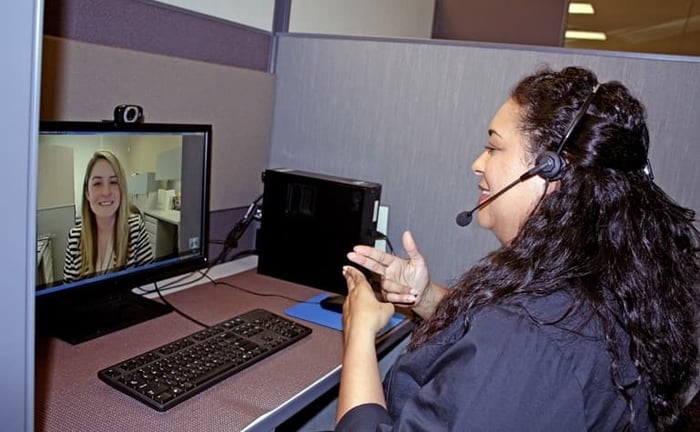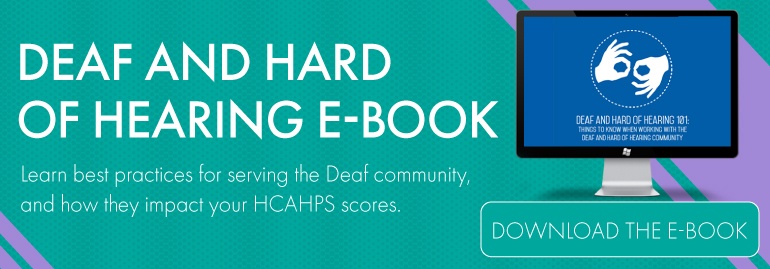
Individuals who are deaf and hard of hearing face a unique set of challenges when seeking medical care. Well-meaning providers want to do the right thing for their patients but may not understand the specifics of what's appropriate.
Here are some dos and don’ts from Deaf experts to help bridge the communication gap:
DOs
DO speak directly to the patient in the second person point of view
Providers often have the urge to speak to the person (in the room or on-screen) who can directly understand them – the interpreter. So they might say something like “Can you please ask Mrs. Smith whether she has a family history of cancer?”
Of course, the provider doesn’t actually expect the interpreter to sign those words “CAN – YOU – ASK…” to the deaf patient. They want the interpreter to sign “Do you have a family history of cancer?”
But asking the interpreter to make those changes takes them out of their role as a conduit for dialogue. And speaking to the interpreter rather than the patient may leave the patient feeling ignored. Instead, providers should face and speak to their deaf patients as they would a hearing individual, then allow the interpreter to “repeat” their words via sign language.
DO use eye contact to improve communication
Hearing people may not be used to prolonged eye contact; most tend to make eye contact for a second or two, look away, and repeat. But Deaf communication relies heavily on eye contact: the blog ASLDeafined explains that “In the Deaf community, once you break eye contact you are no longer listening to the other person. This is considered to be rude and disrespectful.”
Providers should make an effort to look their deaf patients in the eye while conversing, understanding that the patient will need to watch the interpreter as well to understand their signing.
DO consider facial expressions part of the dialogue
According to The Atlantic, “sign language uses face and body movements as part of its grammar.” The piece goes on to describe how facial expressions can even modify spoken words. Providers won’t be fluent in this aspect of Deaf communication, but they should allow their facial expressions to match the content of their message; maintaining a stern face while delivering happy news, for example, may cause confusion until the ASL interpreter clarifies the message.
DON’Ts
DON’T be afraid to use the word “Deaf”
Most of us are socialized to avoid drawing attention to differences in others. This instinct can make some providers hesitant to use the term “deaf,” opting instead for “hearing-impaired,” which seems more sensitive.
However, the National Association of the Deaf (NAD) has explained that the community actually prefers “deaf” and “hard of hearing,” and that they feel “hearing-impaired” focuses negatively on what Deaf individuals can’t do.
“Deaf and hard of hearing people have the right to choose what they wish to be called,” the NAD states on their ‘Frequently Asked Questions’ page. And “overwhelmingly, deaf and hard of hearing people prefer to be called ‘deaf’ or ‘hard of hearing.’"
The NAD also notes that terms like “deaf and dumb” and “deaf-mute” are historical relics best left in the past, as they are offensive to many deaf people today.
DON’T assume the patient uses American Sign Language (ASL)
Assuming a deaf patient in the US uses ASL is like assuming a hearing patient speaks English – you’ll be correct more often than not, but it’s important to realize that deaf language isn’t universal.
We’ve written a full blog post on different methods deaf and hard of hearing individuals use to communicate. In addition to ASL, these methods include:
- Signed English
- Rochester Method
- Home Signs
A professional ASL interpreter should be able to determine quickly whether a deaf patient is proficient in ASL.
DON’T exaggerate your speech or increase your volume
People who feel they are not being understood tend to unconsciously slow their speech, overemphasize words, or speak louder. The Deaf-Hearing Communication Center advises that none of this will help a deaf patient understand their provider, and that the resulting facial contortions will likely confuse those who rely in part on lip-reading to communicate. Instead, “Do not yell or talk loudly… speak normally and avoid speaking too slow or too fast.”
Ready to learn more about the Deaf community and how to provide them with quality care? Download our e-book here:










